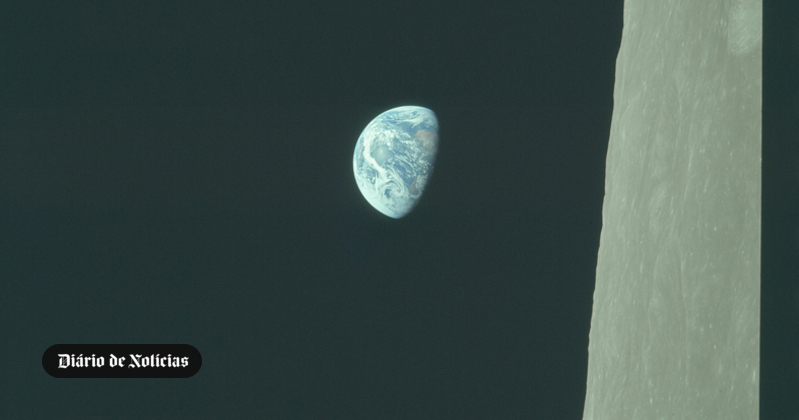At a distance of 6 billion km from the celestial body from which it broke away 13 years ago, the space probe received a command from home: point the high-resolution focal lens of the camera at the back of the instrument and take a final, windowed image. A complete picture of the mother planet. The result: a tiny blob, less than a pixel in a universe of 640,000 pixels that cram the image, captured inside a sunbeam. Thirty-four minutes after the image was taken, on February 14, 1990, the probe accepted the command from Earth, turned off the cameras and continued its journey, at a speed of 64,000 kilometers per hour, towards the boundaries of the solar system.
The previous paragraph could form the conclusion of a science fiction novel, in a final and nostalgic farewell to the planet of origin. This fact occurred on February 14, 1990, at a time when the American space probe Voyager 1 claimed the title of the most distant human object from planet Earth. A decade ago, he completed the approach and study of the planet Saturn, to continue the journey, which is still continuing in 2022, after 45 years, towards interstellar space.
At NASA, the American astronomer, astrophysicist and famous scientist, Carl Sagan, then 55 years old, added the image collected by Voyager 1 to a set of 60 images that the probe sent to Earth between March and May 1990. Images that were linked by signals Radio that covered the distance between the borders of the solar system and our planet, in just over five hours, at a speed of 300 thousand kilometers per second, the speed of light.
Baptismal photo series “Family Portrait”, in the photo taken on February 14, 1990, the most famous member of the clan. The “pale blue dot,” so named, resulted from the combination of three images with green, blue, and violet spectral filters. A point as small as it was fragile, as Carl Sagan later recalled in a lecture he gave at Cornell University, in New York, on October 13, 1994: “The Earth is a very small stage in a vast cosmic arena.”
A fragile scenario, recently captured in a new image, on November 16, 2022, by the Orion capsule, which is part of the Artemis 1 space mission, developed by NASA. A mission that includes, among other goals, the return of humans to the Moon by 2025, later to Mars. This, which will be the first manned flight to land on Earth’s natural satellite since Apollo 17, in 1972, gave us the first complete picture of our planet, taken in the past 50 years, from a manually operated object. The way to the moon. 90,000 kilometers away, the Earth looms in the enveloping darkness.
A family photo reminds us that the photo album of the third planet from the sun is strong with precedents in the 1940s and 1950s, with the first suborbital flights. In the 1960s, in orbit around Earth’s natural satellite, the Lunar Orbiter 1 spacecraft, part of the Orbiter program, was tasked with photographing the lunar surface. There was a need to identify safe landing sites for future manned Apollo missions. Of the more than 2,000 images taken in five uncrewed Orbiter missions, between 1966 and 1967, covering 99% of the lunar surface, one has earned historic status. extravagant in the context of the mission, by not pointing its cameras at a wasteland. On August 23, 1966, Orbiter 1’s camera captured our planet’s first “ascent” with the lunar horizon in the foreground. At a distance of 380,000 km from Earth, the crescent moon visible in the image extends over a horizon that stretches from Istanbul to Cape Town. Skyline “retouched” in 2014 when, within the framework of the LOIRP program (Orbital Lunar Image Recovery Project), the birth of Earth in 1966, was due to the digitization of analog data collected in the mission’s original tapes.
A luminous ascent of the Earth above the lunar horizon occurred twice on Christmas Eve 1968. The Apollo 8 mission carried humans into orbit around the Moon for the first time. Aboard Apollo 8, with astronauts Frank Borman, Jim Lovell, and William Anders, humanity not only laid eyes on the far side of the Moon, but also on the first image of Earth ever taken by human hands from our natural satellite. “Earthrise,” a photograph by William Anders, was included in the 2003 list of 100 Pictures That Changed the World, along with the atomic mushroom in Nagasaki, the X-ray photograph and the landscape that opened the art of photography. (“View from the Window at Le Gras”). In “Earthrise,” award-winning American mountaineer and photographer Galen Rowell identifies it as “the most influential environmental photograph ever taken.” Framed image of orbit over the lunar equator, with the natural satellite edge vertical to planet Earth. This one is hovering in space just to the left of the lunar surface. An image was later rotated 90 degrees to emphasize the terrestrial aurorae.
NASA republished “A Pale Blue Dot” in 2020, the date the photo was taken 30 years ago. The pixels that define our planet from more than 6 billion kilometers away appear closer, thanks to better definition printed by software and image processing technologies of the 21st century. Carl Sagan’s words, spoken at Cornell in 1994, shine today as well as they did three decades ago: “Look again at this place. This here. This is our home. This is us. In it, everyone we love, everyone we know, anyone they’ve ever heard of.” About him, every human being who ever lived, lived his life (…) a speck of dust suspended in a sunbeam (…) Earth is the only known world, so far, that harbors life. There is nowhere else, at least in the near future. Our species can migrate to.

“Coffee trailblazer. Social media ninja. Unapologetic web guru. Friendly music fan. Alcohol fanatic.”

